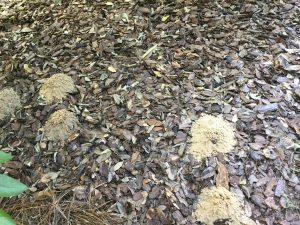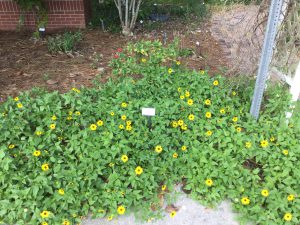
Have you noticed small mounds of dirt forming in your garden or landscape recently or flying insects hovering just above the ground especially near flowering plants? If so, this time of year (September) is when we see these ground-nesting bees enjoying our Florida-Friendly Landscaping™ Demonstration Garden in Bartow and they might just be in your yard as well. We have recently received a few questions in our Plant Clinic about ground dwelling bees in Polk County landscapes as well.
What should you know about these bees?
The ground-nesting bees in our demonstration garden are in the Halictidae family and are also known as sweat bees. While you may think of green metallic-looking bees when you think of sweat bees, they can also be black or brown.
Scientific name:
Dieunomia heteropoda
Geographic distribution:
Found in North America, including Florida.
Appearance:
Just less than one inch in length with black or brown bodies covered in hair.

Habitat:
While they prefer open sandy soils, they are also found in sunny landscape beds in the garden. You may find many mounds within close distance to each other. The female bees may nest solitary by themselves or semi-communal with multiple females nesting together underground in the same tunnel.
Lifecycle:
When the mounds appear, that is a sign that the females are digging underground to create tunnels for living and nesting.
Similar looking bees:
There are other ground-nesting bees that may look like D. heteropoda like Adrena spp. and Nomia spp.
How can you support ground-nesting bees?
Following the principles of Florida-Friendly Landscaping™ will help protect and support pollinators. Ground-nesting bees are best supported by avoiding disturbing the ground in which they are nesting and by providing flowering plants with pollen and nectar. Dieunomia bees generally prefer flowers in the Asteraceae family. In our demonstration garden they are often found on beach sunflower (Helianthus debilis), Starry rosinweed (Silphium asteriscus), Florida greeneyes (Berlandiera subacaulis), and seasonal sunflowers.

Should you be concerned about ground dwelling bees like Dieunomia heteropoda?
No, ground dwelling bees like D. heteropoda are solitary bees that are not aggressive when left alone. Stings are more common if the bees are handled. Interestingly, sweat bees, get their common name from their attraction to human perspiration or sweat and the salt found in it. Again, these bees are not aggressive and are not a cause for alarm or action.
So, what is the good news about these bees?
Many ground-nesting bees are important for the pollination of wildflowers and even food crops. If these bees are present in your garden or landscape, know that you are providing an excellent habitat to support them and other pollinators. Keep up the good work!
More resources on bees and other ground-nesting bees:
- Bees of Florida https://edis.ifas.ufl.edu/pdf/IN/IN128500.pdf
- What is it: Dieunomia bees https://blogs.ifas.ufl.edu/pestalert/2014/10/07/what-is-it-dieunomia-bees/
- Attracting Native Bees to Your Florida Landscape https://edis.ifas.ufl.edu/pdf/IN/IN125500.pdf
- Perfect Plants for Pollinators https://gardeningsolutions.ifas.ufl.edu/design/gardening-with-wildlife/bee-plants.html
- Gardening for Bees https://gardeningsolutions.ifas.ufl.edu/design/gardening-with-wildlife/gardening-for-bees.html
- Ground-Dwelling Bees https://nwdistrict.ifas.ufl.edu/hort/2021/10/21/ground-dwelling-bees/
References:
- Mader, Eric, Matthew Shepherd, Mace Vaughan, Scott Black, and Gretchen LeBuhn. The Xerces Society Guide: Attracting Native Pollinators. (Massachussetts: Storey Publishing, 2011).
- Mason, Lisa, B. Sayre-Chavez, C. O’Brien, and A. Seshadri. A Beginner’s Field Gide to Identifying Bees. Colorado State University Extension. https://extension.colostate.edu/wp-content/uploads/2022/03/BeginnerBeeFieldGuide_LowRezWeb_28Feb2022.pdf
- University of Minnesota Bee Lab “Native Bees” https://beelab.umn.edu/Native-Bees
An Equal Opportunity Institution.
 0
0
